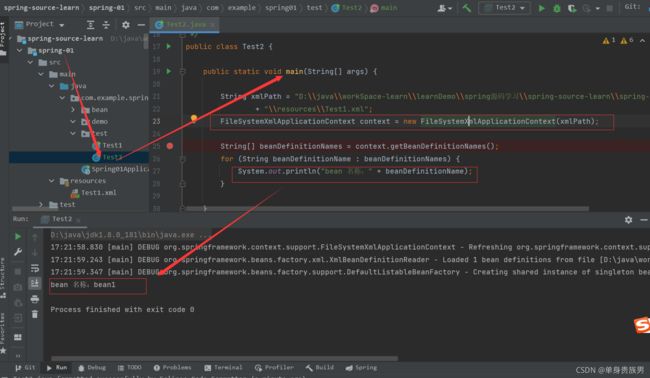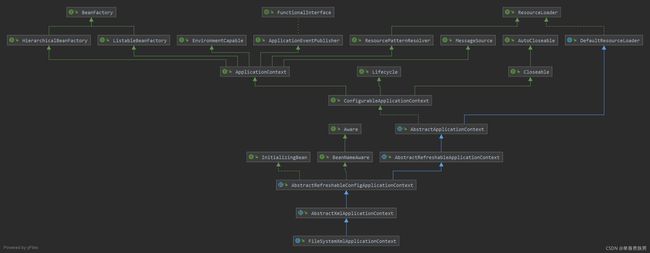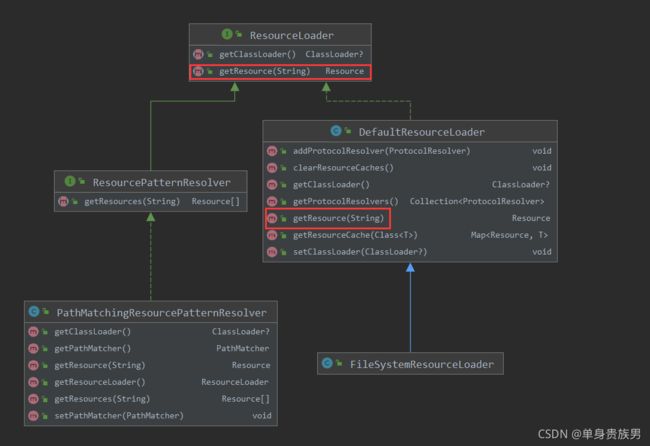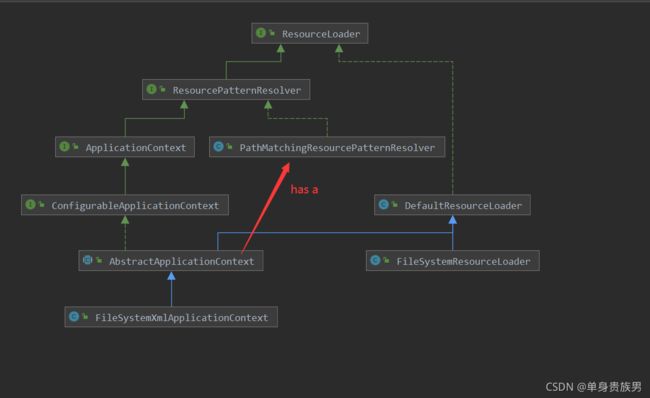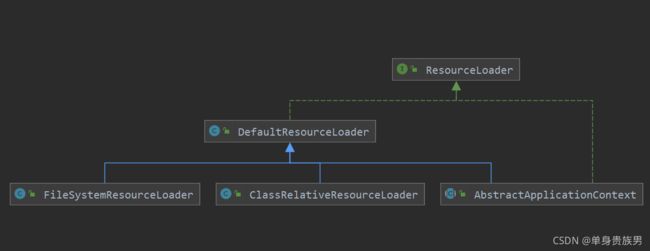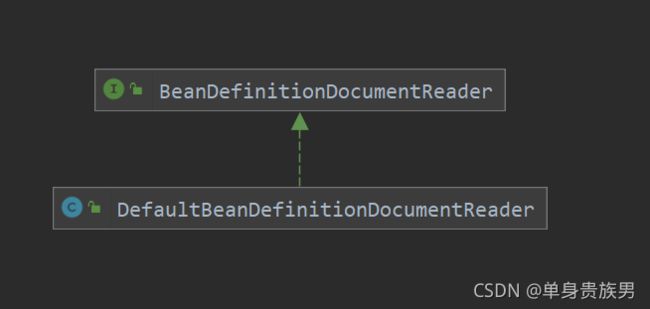spring源码--05--IOC原理--FileSystemXmlApplicationContext(IOC容器)的初始化(细)
spring–05–IOC原理–FileSystemXmlApplicationContext(IOC容器)的初始化(细)
1、 验证过程
代码地址
https://gitee.com/DanShenGuiZu/learnDemo/tree/master/spring源码学习/spring-source-learn/spring-01
1.1、验证代码
public class Test2 {
public static void main(String[] args) {
String xmlPath = "D:\\java\\workSpace-learn\\learnDemo\\spring源码学习\\spring-source-learn\\spring-01\\src\\main"
+ "\\resources\\Test1.xml";
FileSystemXmlApplicationContext context = new FileSystemXmlApplicationContext(xmlPath);
String[] beanDefinitionNames = context.getBeanDefinitionNames();
for (String beanDefinitionName : beanDefinitionNames) {
System.out.println("bean 名称:" + beanDefinitionName);
}
}
}
1.2、验证结果
2、 FileSystemXmlApplicationContext 继承关系图
3、 FileSystemXmlApplicationContext 源码
/**
* 通过 xml 配置文件来注册BeanDefinition
*/
public class FileSystemXmlApplicationContext extends AbstractXmlApplicationContext {
/**
* 创建构造函数
*/
public FileSystemXmlApplicationContext() {
}
/**
* 创建构造函数
*
* @param parent the parent context
* @see #setConfigLocation
* @see #setConfigLocations
* @see #afterPropertiesSet()
*/
public FileSystemXmlApplicationContext(ApplicationContext parent) {
super(parent);
}
/**
* 通过xml文件的路径,构建FileSystemXmlApplicationContext对象,并刷新上下文
*/
public FileSystemXmlApplicationContext(String configLocation) throws BeansException {
this(new String[] { configLocation }, true, null);
}
/**
* 通过xml文件的路径,构建FileSystemXmlApplicationContext对象,并刷新上下文
*/
public FileSystemXmlApplicationContext(String... configLocations) throws BeansException {
this(configLocations, true, null);
}
/**
* 通过xml文件的路径,和parent构建FileSystemXmlApplicationContext对象,并刷新上下文
*/
public FileSystemXmlApplicationContext(String[] configLocations, ApplicationContext parent) throws BeansException {
this(configLocations, true, parent);
}
/**
* 通过xml文件的路径 构建FileSystemXmlApplicationContext对象,通过refresh控制是否刷新上下文
*
*/
public FileSystemXmlApplicationContext(String[] configLocations, boolean refresh) throws BeansException {
this(configLocations, refresh, null);
}
/**
* 通过xml文件的路径和parent 构建FileSystemXmlApplicationContext对象,通过refresh控制是否刷新上下文
*
*/
public FileSystemXmlApplicationContext(String[] configLocations, boolean refresh,
@Nullable ApplicationContext parent) throws BeansException {
//调用父类容器的构造方法,为容器设置好BeanDefinition资源加载器。
super(parent);
//设置Bean 配置文件的路径。
setConfigLocations(configLocations);
if (refresh) {
refresh();
}
}
/**
* 将资源路径解析为文件系统路径
*/
@Override
protected Resource getResourceByPath(String path) {
if (path.startsWith("/")) {
path = path.substring(1);
}
return new FileSystemResource(path);
}
}
核心代码是下面这个
/**
* 通过xml文件的路径和parent 构建FileSystemXmlApplicationContext对象,通过refresh控制是否刷新上下文
*
*/
public FileSystemXmlApplicationContext(String[] configLocations, boolean refresh,
@Nullable ApplicationContext parent) throws BeansException {
//调用父类容器的构造方法,为容器设置好Bean资源加载器。
super(parent);
//设置BeanDefinition 配置文件的路径。
setConfigLocations(configLocations);
if (refresh) {
refresh();
}
}
4、 设置资源加载器和资源定位(BeanDefinition的Resource定位)
追踪FileSystemXmlApplicationContext 的super(parent)代码,发现其父类是AbstractApplicationContext。
4.1、 AbstractApplicationContext 初始化IOC容器的主要源码
public abstract class AbstractApplicationContext extends DefaultResourceLoader
implements ConfigurableApplicationContext {
// 静态初始化块,在整个容器创建过程中只执行一次
static {
// 为了避免应用程序在Weblogic8.1关闭时出现类加载异常问题,加载IOC容器关闭事件(ContextClosedEvent)类
ContextClosedEvent.class.getName();
}
// 父上下文
@Nullable
private ApplicationContext parent;
// 用于上下文的资源解析器
private ResourcePatternResolver resourcePatternResolver;
/**
* 构造函数
*/
public AbstractApplicationContext() {
this.resourcePatternResolver = getResourcePatternResolver();
}
/**
* 构造函数
*
* @param parent 父上下文
*/
public AbstractApplicationContext(@Nullable ApplicationContext parent) {
this();
setParent(parent);
}
/**
* 构建资源解析器
*/
protected ResourcePatternResolver getResourcePatternResolver() {
return new PathMatchingResourcePatternResolver(this);
}
// ---------------------------------------------------------------------
// Implementation of ConfigurableApplicationContext interface
// ---------------------------------------------------------------------
/**
* 设置 application 上下文的parent
*/
@Override
public void setParent(@Nullable ApplicationContext parent) {
// 设置父上下文
this.parent = parent;
if (parent != null) {
// 获取父上下文的配置环境, 并且合并到当前上下文的环境中
Environment parentEnvironment = parent.getEnvironment();
if (parentEnvironment instanceof ConfigurableEnvironment) {
getEnvironment().merge((ConfigurableEnvironment) parentEnvironment);
}
}
}
}
4.2、AbstractApplicationContext构造方法中调用getResourcePatternResolver方法创建Spring资源加载器
// AbstractApplicationContext构造方法
public AbstractApplicationContext() {
this.resourcePatternResolver = getResourcePatternResolver();
}
// 获取资源解析器
protected ResourcePatternResolver getResourcePatternResolver() {
return new PathMatchingResourcePatternResolver(this);
}
// 设置Spring的资源加载器
public PathMatchingResourcePatternResolver(ResourceLoader resourceLoader) {
Assert.notNull(resourceLoader, "ResourceLoader must not be null");
//设置Spring的资源加载器
this.resourceLoader = resourceLoader;
}
4.3、在设置容器的资源加载器之后,接下来FileSystemXmlApplicationContet执行setConfigLocations方法通过调用其父类AbstractRefreshableConfigApplicationContext的方法 设置BeanDefinition 配置文件的路径,该方法的源码如下:
/**
* 处理单个资源文件路径为一个字符串的情况
* 多个资源文件路径之间用" ,; /t/n"分隔,转换数组形式去解析
* 举例:
* location="a.xml,b.xml";
* location="a.xml;b.xml";
* location="a.xml b.xml";
*/
public void setConfigLocation(String location) {
// String CONFIG_LOCATION_DELIMITERS = ",; /t/n";
setConfigLocations(StringUtils.tokenizeToStringArray(location, CONFIG_LOCATION_DELIMITERS));
}
/**
* 解析Bean 资源文件的路径,处理多个资源文件字符串数组
* 举例
* locations=newString[]{"a.xml","b.xml"}
*/
public void setConfigLocations(@Nullable String... locations) {
if (locations != null) {
Assert.noNullElements(locations, "Config locations must not be null");
// 初始化数组
this.configLocations = new String[locations.length];
for (int i = 0; i < locations.length; i++) {
// resolvePath 将字符串解析为路径
this.configLocations[i] = resolvePath(locations[i]).trim();
}
} else {
this.configLocations = null;
}
}
5、 AbstractApplicationContext的refresh函数载入BeanDefinition过程(BeanDefinition的载入)
- Spring IOC容器对BeanDefinition的载入是从refresh()函数开始的
- refresh()是一个模板方法
- refresh()方法的作用
- 在创建IOC容器前,如果已经有容器存在,则需要把已有的容器销毁和关闭,在重新建立好的容器。
- 在新建立好的容器中
- 对容器进行初始化
- 对BeanDefinition资源进行载入
5.1、 FileSystemXmlApplicationContext 调用父类AbstractApplicationContext的refresh()函数
@Override
// 在创建IOC容器前,如果已经有容器存在,则需要把已有的容器销毁和关闭,在重新建立新容器。
// 在新建立的容器中,对容器进行初始化,对BeanDefinition资源进行载入
public void refresh() throws BeansException, IllegalStateException {
// 同步锁
synchronized (this.startupShutdownMonitor) {
// 准备刷新上下文,设置其启动日期和活动标志,执行属性源文件的初始化。
prepareRefresh();
// 告诉子类 启动refreshBeanFactory()方法
// BeanDefinition资源文件的载入从子类的refreshBeanFactory()方法启动
ConfigurableListableBeanFactory beanFactory = obtainFreshBeanFactory();
// 为BeanFactory 配置 容器特性,例如类加载器、事件处理器(post-processors.)
prepareBeanFactory(beanFactory);
try {
// 为上下文工厂(容器)的某些子类指定 postProcess事件 处理器
postProcessBeanFactory(beanFactory);
// 调用Bean工厂的后置处理器
invokeBeanFactoryPostProcessors(beanFactory);
// 为BeanFactory注册BeanPost事件处理器.
// BeanPostProcessor是Bean后置处理器,用于监听容器触发的事件
registerBeanPostProcessors(beanFactory);
// 初始化信息源,和国际化相关.
// 如果在此上下文中未初始化,请使用父级。
initMessageSource();
// 初始化 ApplicationEventMulticaster 事件
initApplicationEventMulticaster();
// 在特定的上下文(容器),调用子类某些特殊的Bean初始化方法
onRefresh();
// 为ApplicationEventMulticaster事件 注册事件监听器.
registerListeners();
// 初始化所有剩余的单例Bean.
finishBeanFactoryInitialization(beanFactory);
// 初始化容器的生命周期事件处理器,并发布容器的生命周期事件
finishRefresh();
}
catch (BeansException ex) {
if (logger.isWarnEnabled()) {
logger.warn("Exception encountered during context initialization - "
+ "cancelling refresh attempt: " + ex);
}
// 销毁已创建的单例Bean,释放资源
destroyBeans();
// 取消refresh操作,重置容器的 活动标志
cancelRefresh(ex);
// 将异常传播到调用方
throw ex;
}
finally {
// 重置Spring的公共反射元数据缓存,特别是
// ReflectionUtils、
// AnnotationUtils、
// ResolvableType、
// CachedIntrospectionResults的缓存。
resetCommonCaches();
}
}
}
BeanDefinition资源文件的载入从子类的refreshBeanFactory()方法启动
5.2、 AbstractApplicationContext.obtainFreshBeanFactory()方法调用子类容器的refreshBeanFactory()方法,代码如下:
/**
* 告诉子类刷新内部bean工厂。
*
*/
protected ConfigurableListableBeanFactory obtainFreshBeanFactory() {
// 这里使用了委派设计模式,父类定义了抽象的refreshBeanFactory()方法,具体实现调用子类容器的refreshBeanFactory()方法
refreshBeanFactory();
return getBeanFactory();
}
6、 AbstractApplicationContext子类的refreshBeanFactory()方法:
AbstractApplicationContext类中只抽象定义了refreshBeanFactory()方法,容器真正调用的是其子类AbstractRefreshableApplicationContext
6.1、 AbstractRefreshableApplicationContext 的 refreshBeanFactory 方法
/**
*
* 此实现将真正刷新这个上下文的bean工厂, 如果bean工程存在,就先关闭, 并初始化一个新的bean工程。
*/
@Override
protected final void refreshBeanFactory() throws BeansException {
// 如果已经有容器,销毁容器中的bean,关闭容器
if (hasBeanFactory()) {
// 销毁容器中的bean
destroyBeans();
// 关闭容器
closeBeanFactory();
}
try {
// 创建IOC容器
DefaultListableBeanFactory beanFactory = createBeanFactory();
beanFactory.setSerializationId(getId());
// 对IOC容器进行定制化,如设置启动参数,开启注解的自动装配等
customizeBeanFactory(beanFactory);
// 调用载入BeanDefinition的方法,主要这里使用了一个委派模式,在当前类中定义了抽象loadBeanDefinitions方法,具体由子类去实现
loadBeanDefinitions(beanFactory);
this.beanFactory = beanFactory;
} catch (IOException ex) {
throw new ApplicationContextException("I/O error parsing bean definition source for " + getDisplayName(),ex);
}
}
7、 AbstractRefreshableApplicationContext子类的loadBeanDefinitions方法
AbstractRefreshableApplicationContext中定义了抽象loadBeanDefinitions方法,容器真正调用的是其子类AbstractXmlApplicationContext.loadBeanDefinitions 方法
7.1、 AbstractXmlApplicationContext.loadBeanDefinitions 主要源码
public abstract class AbstractXmlApplicationContext extends AbstractRefreshableConfigApplicationContext {
/**
* xml 验证
*/
private boolean validating = true;
/**
* 构造方法
*/
public AbstractXmlApplicationContext() {
}
/**
* 构造方法
*/
public AbstractXmlApplicationContext(@Nullable ApplicationContext parent) {
super(parent);
}
/**
* 设置是否xml验证
*/
public void setValidating(boolean validating) {
this.validating = validating;
}
/**
* 实现父类抽象的载入Bean定义方法
*
*/
@Override
protected void loadBeanDefinitions(DefaultListableBeanFactory beanFactory) throws BeansException, IOException {
// 创建XmlBeanDefinitionReader,即创建BeanDefinition读取器,并通过回调设置到容器中去,容器使用该读取器读取BeanDefinition资源
XmlBeanDefinitionReader beanDefinitionReader = new XmlBeanDefinitionReader(beanFactory);
// 为BeanDefinition读取器 设置 资源加载环境
beanDefinitionReader.setEnvironment(this.getEnvironment());
// 为beanDefinitionReader设置Spring资源加载器,
// AbstractXmlApplicationContext的父类AbstractApplicationContext继承DefaultResourceLoader,因此,容器本身也是一个资源加载器
beanDefinitionReader.setResourceLoader(this);
// 为Bean读取器设置SAX xml解析器
beanDefinitionReader.setEntityResolver(new ResourceEntityResolver(this));
// 当Bean读取器读取Bean定义的Xml资源文件时,是否启用Xml的校验机制
initBeanDefinitionReader(beanDefinitionReader);
// Bean读取器真正实现加载的方法
loadBeanDefinitions(beanDefinitionReader);
}
/**
* 初始化 beanDefinitionReader,用于加载bean,默认实现是空,可以在子类中重写,例如:
* 启用Xml的校验机制或
* 用于不同的XmlBeanDefinitionParser实现
*/
protected void initBeanDefinitionReader(XmlBeanDefinitionReader reader) {
reader.setValidating(this.validating);
}
// Xml Bean读取器加载Bean定义资源
protected void loadBeanDefinitions(XmlBeanDefinitionReader reader) throws BeansException, IOException {
// 获取BeanDefinition资源的定位
Resource[] configResources = getConfigResources();
//由于我们使用FileSystemXmlApplicationContext作为例子分析,因此getConfigResources的返回值为null
if (configResources != null) {
// Xml BeanDefinitionReader 调用父类AbstractBeanDefinitionReader.loadBeanDefinitions方法读取BeanDefinition资源
reader.loadBeanDefinitions(configResources);
}
//如果子类中获取的beanDefinition 资源定位为空,则获取FileSystemXmlApplicationContext构造方法中setConfigLocations方法设置的资源
String[] configLocations = getConfigLocations();
if (configLocations != null) {
// Xml BeanDefinitionReader 调用父类AbstractBeanDefinitionReader.loadBeanDefinitions方法读取BeanDefinition资源
reader.loadBeanDefinitions(configLocations);
}
}
/**
*
* 使用XML Bean 定义文件,返回一个资源对象数组 默认实现返回 null。子类可以重写
* 这里又使用了一个委托模式,调用子类的获取 BeanDefinition资源定位的方法
* 该方法在ClassPathXmlApplicationContext中进行实现
*
*/
@Nullable
protected Resource[] getConfigResources() {
return null;
}
8、 AbstractBeanDefinitionReader读取Bean定义资源
8.1、 AbstractBeanDefinitionReader 继承关系图
8.2、 AbstractBeanDefinitionReader.loadBeanDefinitions方法源码如下
public abstract class AbstractBeanDefinitionReader implements BeanDefinitionReader, EnvironmentCapable {
// bean 名称生成器
private BeanNameGenerator beanNameGenerator = DefaultBeanNameGenerator.INSTANCE;
/**
* 从指定的资源位置加载bean定义
*/
@Override
public int loadBeanDefinitions(Resource... resources) throws BeanDefinitionStoreException {
Assert.notNull(resources, "Resource array must not be null");
int count = 0;
for (Resource resource : resources) {
// 委派调用其子类XmlBeanDefinitionReader.loadBeanDefinitions 方法,实现加载功能
count += loadBeanDefinitions(resource);
}
return count;
}
/**
* 从指定的资源位置加载bean定义
*/
@Override
public int loadBeanDefinitions(String location) throws BeanDefinitionStoreException {
return loadBeanDefinitions(location, null);
}
/**
* 从指定的资源位置加载bean定义
*/
public int loadBeanDefinitions(String location, @Nullable Set actualResources)
throws BeanDefinitionStoreException {
// 获取在IOC容器初始化过程中设置的资源加载器
ResourceLoader resourceLoader = getResourceLoader();
if (resourceLoader == null) {
throw new BeanDefinitionStoreException(
"Cannot load bean definitions from location [" + location + "]: no ResourceLoader available");
}
if (resourceLoader instanceof ResourcePatternResolver) {
// Resource pattern matching available.
try {
// 获取BeanDefinition 的资源文件
// 加载多个指定位置的BeanDefinition资源文件
Resource[] resources = ((ResourcePatternResolver) resourceLoader).getResources(location);
// 委派调用其子类XmlBeanDefinitionReader.loadBeanDefinitions 方法,实现加载功能
int count = loadBeanDefinitions(resources);
if (actualResources != null) {
Collections.addAll(actualResources, resources);
}
if (logger.isTraceEnabled()) {
logger.trace("Loaded " + count + " bean definitions from location pattern [" + location + "]");
}
return count;
} catch (IOException ex) {
throw new BeanDefinitionStoreException(
"Could not resolve bean definition resource pattern [" + location + "]", ex);
}
} else {
// 获取BeanDefinition 的资源文件
// 加载单个指定位置的BeanDefinition资源文件
Resource resource = resourceLoader.getResource(location);
// 委派调用其子类XmlBeanDefinitionReader.loadBeanDefinitions 方法,实现加载功能
int count = loadBeanDefinitions(resource);
if (actualResources != null) {
actualResources.add(resource);
}
if (logger.isTraceEnabled()) {
logger.trace("Loaded " + count + " bean definitions from location [" + location + "]");
}
return count;
}
}
@Override
// 重载方法,调用loadBeanDefinitions(String);
// 也是我们代码要走的地方
public int loadBeanDefinitions(String... locations) throws BeanDefinitionStoreException {
Assert.notNull(locations, "Location array must not be null");
int count = 0;
for (String location : locations) {
count += loadBeanDefinitions(location);
}
return count;
}
}
8.3、 什么源码主要就做了下面几件事
-
获取在IOC容器初始化过程中设置的资源加载器
ResourceLoader resourceLoader = getResourceLoader(); -
获取要加载的资源。对应方法
resourceLoader.getResource(location) 。 -
加载loadBeanDefinitions
子类XmlBeanDefinitionReader的loadBeanDefinitions方法。
8.4、 ResourceLoader与ApplicationContext的继承关系图
上面源码中,有这样代码
// 获取在IOC容器初始化过程中设置的资源加载器
ResourceLoader resourceLoader = getResourceLoader();
.
.
.
.
.
// 获取BeanDefinition 的资源文件
// 加载多个指定位置的BeanDefinition资源文件
Resource[] resources = ((ResourcePatternResolver) resourceLoader).getResources(location);
结合上面的ResourceLoader与ApplicationContext的继承关系图,可以知道此时调用的是DefaultResourceLoader中的getResource()方法来定位Resource,因为FileSystemXmlApplicationContext 是 DefaultResourceLoader的子类,会继承这个方法。
9、 DefaultResourceLoader的getResource方法 源码
XmlBeanDefinitionReader通过调用父类DefaultResourceLoader的getResource方法获取要加载的资源
9.1、DefaultResourceLoader 继承关系图
9.2、DefaultResourceLoader.getResource方法 源码
public class DefaultResourceLoader implements ResourceLoader {
@Nullable
private ClassLoader classLoader;
private final Set protocolResolvers = new LinkedHashSet<>(4);
private final Map, Map> resourceCaches = new ConcurrentHashMap<>(4);
/**
* 构造方法
*/
public DefaultResourceLoader() {
}
/**
* 构造方法
*
* @param classLoader 用于加载 class路径资源的类加载器
*/
public DefaultResourceLoader(@Nullable ClassLoader classLoader) {
this.classLoader = classLoader;
}
/**
* 返回类加载器,如果classLoader为空,返回默认的类加载器
*/
@Override
@Nullable
public ClassLoader getClassLoader() {
return (this.classLoader != null ? this.classLoader : ClassUtils.getDefaultClassLoader());
}
/**
* 返回当前注册的协议解析器的集合
*
*/
public Collection getProtocolResolvers() {
return this.protocolResolvers;
}
@Override
public Resource getResource(String location) {
Assert.notNull(location, "Location must not be null");
// 返回当前注册的协议解析器的集合
for (ProtocolResolver protocolResolver : getProtocolResolvers()) {
// 解析为资源文件,一旦解析为资源文件就跳出方法
Resource resource = protocolResolver.resolve(location, this);
if (resource != null) {
return resource;
}
}
// 将/转为Resource
if (location.startsWith("/")) {
return getResourceByPath(location);
} else if (location.startsWith("classpath:")) {
// 如果是类路径的方式,那需要使用ClassPathResource 来得到bean 文件的资源对象
return new ClassPathResource(location.substring(CLASSPATH_URL_PREFIX.length()), getClassLoader());
} else {
try {
// 如果是URL 方式,使用UrlResource 作为bean 文件的资源对象
URL url = new URL(location);
return (ResourceUtils.isFileURL(url) ? new FileUrlResource(url) : new UrlResource(url));
} catch (MalformedURLException ex) {
// 如果既不是/,classpath:,URL,则调用容器本身的getResourceByPath方法获取Resource
return getResourceByPath(location);
}
}
}
/**
* 将path转为Resource
*/
protected Resource getResourceByPath(String path) {
return new ClassPathContextResource(path, getClassLoader());
}
}
FileSystemXmlApplicationContext容器提供了getResourceByPath方法的实现,就是为了处理既不是classpath标识,又不是URL标识的Resource定位这种情况。
/**
* 将资源路径解析为文件系统路径
* 使我们代码实际走的地方
*/
@Override
protected Resource getResourceByPath(String path) {
if (path.startsWith("/")) {
path = path.substring(1);
}
return new FileSystemResource(path);
}
10、 XmlBeanDefinitionReader加载Bean定义资源
回到 AbstractBeanDefinitionReader.loadBeanDefinitions方法
// 获取BeanDefinition 的资源文件
// 加载多个指定位置的BeanDefinition资源文件
Resource[] resources = ((ResourcePatternResolver) resourceLoader).getResources(location);
// 委派调用其子类XmlBeanDefinitionReader.loadBeanDefinitions 方法,实现加载功能
int count = loadBeanDefinitions(resources);
我们点击 loadBeanDefinitions 方法
/**
* 从指定的资源位置加载bean定义
*/
@Override
public int loadBeanDefinitions(Resource... resources) throws BeanDefinitionStoreException {
Assert.notNull(resources, "Resource array must not be null");
int count = 0;
for (Resource resource : resources) {
// 委派调用其子类XmlBeanDefinitionReader.loadBeanDefinitions 方法,实现加载功能
count += loadBeanDefinitions(resource);
}
return count;
}
可以看到实际还是调用子类XmlBeanDefinitionReader.loadBeanDefinitions 方法,实现加载功能
10.1、 XmlBeanDefinitionReader加载Bean定义资源
public class XmlBeanDefinitionReader extends AbstractBeanDefinitionReader {
//文档加载器
private DocumentLoader documentLoader = new DefaultDocumentLoader
.
.
.
.
.
.
.
/**
* XmlBeanDefinitionReader加载资源的入口方法 通过 xml配置文件 加载BeanDefinition
*/
@Override
public int loadBeanDefinitions(Resource resource) throws BeanDefinitionStoreException {
// 将读入的XML资源进行特殊编码处理
return loadBeanDefinitions(new EncodedResource(resource));
}
/**
* 通过 xml配置文件 加载BeanDefinition
*
* @param encodedResource xml文件的 描述对象,可以指定编码
*
*/
public int loadBeanDefinitions(EncodedResource encodedResource) throws BeanDefinitionStoreException {
Assert.notNull(encodedResource, "EncodedResource must not be null");
if (logger.isTraceEnabled()) {
logger.trace("Loading XML bean definitions from " + encodedResource);
}
// 获取EncodedResource 集合
Set currentResources = this.resourcesCurrentlyBeingLoaded.get();
if (!currentResources.add(encodedResource)) {
throw new BeanDefinitionStoreException(
"Detected cyclic loading of " + encodedResource + " - check your import definitions!");
}
// 将资源文件转为InputStream的IO流
try (InputStream inputStream = encodedResource.getResource().getInputStream()) {
// 从InputStream中得到XML的解析源
InputSource inputSource = new InputSource(inputStream);
if (encodedResource.getEncoding() != null) {
// 设置编码
inputSource.setEncoding(encodedResource.getEncoding());
}
// 具体的读取过程
return doLoadBeanDefinitions(inputSource, encodedResource.getResource());
} catch (IOException ex) {
throw new BeanDefinitionStoreException(
"IOException parsing XML document from " + encodedResource.getResource(), ex);
} finally {
// 释放资源
currentResources.remove(encodedResource);
if (currentResources.isEmpty()) {
this.resourcesCurrentlyBeingLoaded.remove();
}
}
}
/**
* 真正载入LoadBeanDefinition 的代码
*/
protected int doLoadBeanDefinitions(InputSource inputSource, Resource resource)
throws BeanDefinitionStoreException {
try {
// 将XML文件转换为DOM对象,解析过程由documentLoader实现
Document doc = doLoadDocument(inputSource, resource);
// 注册bean,返回注册的个数
int count = registerBeanDefinitions(doc, resource);
if (logger.isDebugEnabled()) {
logger.debug("Loaded " + count + " bean definitions from " + resource);
}
return count;
} catch (BeanDefinitionStoreException ex) {
throw ex;
} catch (SAXParseException ex) {
throw new XmlBeanDefinitionStoreException(resource.getDescription(),
"Line " + ex.getLineNumber() + " in XML document from " + resource + " is invalid", ex);
} catch (SAXException ex) {
throw new XmlBeanDefinitionStoreException(resource.getDescription(),
"XML document from " + resource + " is invalid", ex);
} catch (ParserConfigurationException ex) {
throw new BeanDefinitionStoreException(resource.getDescription(),
"Parser configuration exception parsing XML from " + resource, ex);
} catch (IOException ex) {
throw new BeanDefinitionStoreException(resource.getDescription(),
"IOException parsing XML document from " + resource, ex);
} catch (Throwable ex) {
throw new BeanDefinitionStoreException(resource.getDescription(),
"Unexpected exception parsing XML document from " + resource, ex);
}
}
/**
*
* 使用 DocumentLoader 加载xml,返回Document
*
* @param inputSource 来自xml文件的 SAX InputSource
* @param resource XML 文件资源描述对象
* @return Document
*/
protected Document doLoadDocument(InputSource inputSource, Resource resource) throws Exception {
// 这里走的是DefaultDocumentLoader.loadDocument方法。
return this.documentLoader.loadDocument(inputSource, getEntityResolver(), this.errorHandler,
getValidationModeForResource(resource), isNamespaceAware());
}
/**
* 获取验证模式
*/
protected int getValidationModeForResource(Resource resource) {
int validationModeToUse = getValidationMode();
if (validationModeToUse != VALIDATION_AUTO) {
return validationModeToUse;
}
int detectedMode = detectValidationMode(resource);
if (detectedMode != VALIDATION_AUTO) {
return detectedMode;
}
// Hmm, we didn't get a clear indication... Let's assume XSD,
// since apparently no DTD declaration has been found up until
// detection stopped (before finding the document's root tag).
return VALIDATION_XSD;
}
/**
* 通过xml文件标识获取验证模式
*/
protected int detectValidationMode(Resource resource) {
if (resource.isOpen()) {
throw new BeanDefinitionStoreException("Passed-in Resource [" + resource + "] contains an open stream: "
+ "cannot determine validation mode automatically. Either pass in a Resource "
+ "that is able to create fresh streams, or explicitly specify the validationMode "
+ "on your XmlBeanDefinitionReader instance.");
}
InputStream inputStream;
try {
inputStream = resource.getInputStream();
} catch (IOException ex) {
throw new BeanDefinitionStoreException(
"Unable to determine validation mode for [" + resource + "]: cannot open InputStream. "
+ "Did you attempt to load directly from a SAX InputSource without specifying the "
+ "validationMode on your XmlBeanDefinitionReader instance?",
ex);
}
try {
return this.validationModeDetector.detectValidationMode(inputStream);
} catch (IOException ex) {
throw new BeanDefinitionStoreException("Unable to determine validation mode for [" + resource
+ "]: an error occurred whilst reading from the InputStream.", ex);
}
}
/**
* 通过Document 注册 beanDefinitions
*/
public int registerBeanDefinitions(Document doc, Resource resource) throws BeanDefinitionStoreException {
// 创建BeanDefinitionDocument的读取器
BeanDefinitionDocumentReader documentReader = createBeanDefinitionDocumentReader();
// 注册前的bean数量
int countBefore = getRegistry().getBeanDefinitionCount();
//注册
documentReader.registerBeanDefinitions(doc, createReaderContext(resource));
// 注册的数量
return getRegistry().getBeanDefinitionCount() - countBefore;
}
.
.
.
.
.
.
.
}
11、DocumentLoader将Bean定义资源转换为Document对象:
回到XmlBeanDefinitionReader,我们我们原先的代码
.
.
.
.
.
//文件加载器
private DocumentLoader documentLoader = new DefaultDocumentLoader
.
.
.
.
.
// 这里走的是DefaultDocumentLoader.loadDocument方法。
return this.documentLoader.loadDocument。
.
.
.
.
.
11.1、DefaultDocumentLoader 继承关系图
11.2、DefaultDocumentLoader.loadDocument 源码
public class DefaultDocumentLoader implements DocumentLoader {
/**
* 使用标准的JAXP将Bean定义资源转换成document对象
*/
@Override
public Document loadDocument(InputSource inputSource, EntityResolver entityResolver, ErrorHandler errorHandler,
int validationMode, boolean namespaceAware) throws Exception {
// 创建Doc文件解析器工厂
DocumentBuilderFactory factory = createDocumentBuilderFactory(validationMode, namespaceAware);
if (logger.isTraceEnabled()) {
logger.trace("Using JAXP provider [" + factory.getClass().getName() + "]");
}
// 创建Doc文档解析器
DocumentBuilder builder = createDocumentBuilder(factory, entityResolver, errorHandler);
// 解析Spring的Bean定义资源
return builder.parse(inputSource);
}
/**
* 创建文件解析器工厂
*
* validationMode:xml文件校验的模式
*
* namespaceAware:是否提供对XML命名空间的支持
*/
protected DocumentBuilderFactory createDocumentBuilderFactory(int validationMode, boolean namespaceAware)
throws ParserConfigurationException {
// 创建文档解析工厂
DocumentBuilderFactory factory = DocumentBuilderFactory.newInstance();
// 是否提供对XML命名空间的支持
factory.setNamespaceAware(namespaceAware);
// 设置解析XML的校验
if (validationMode != XmlValidationModeDetector.VALIDATION_NONE) {
factory.setValidating(true);
if (validationMode == XmlValidationModeDetector.VALIDATION_XSD) {
// Enforce namespace aware for XSD...
factory.setNamespaceAware(true);
try {
factory.setAttribute(SCHEMA_LANGUAGE_ATTRIBUTE, XSD_SCHEMA_LANGUAGE);
} catch (IllegalArgumentException ex) {
ParserConfigurationException pcex = new ParserConfigurationException(
"Unable to validate using XSD: Your JAXP provider [" + factory
+ "] does not support XML Schema. Are you running on Java 1.4 with Apache Crimson? "
+ "Upgrade to Apache Xerces (or Java 1.5) for full XSD support.");
pcex.initCause(ex);
throw pcex;
}
}
}
return factory;
}
}
至此Spring IOC容器根据定位的Bean定义资源文件,将其加载读入并转换成为Document对象过程完成。
12、XmlBeanDefinitionReader解析载入的Bean定义资源文件
回到 10.1 的代码
public class XmlBeanDefinitionReader extends AbstractBeanDefinitionReader {
.
.
.
/**
* 真正载入LoadBeanDefinition 的代码
*/
protected int doLoadBeanDefinitions(InputSource inputSource, Resource resource)
throws BeanDefinitionStoreException {
try {
// 将XML文件转换为DOM对象,解析过程由documentLoader实现
Document doc = doLoadDocument(inputSource, resource);
// 注册bean,返回注册的个数
int count = registerBeanDefinitions(doc, resource);
.
.
.
我们接下来解析registerBeanDefinitions方法
12.1、XmlBeanDefinitionReader.registerBeanDefinitions 源码
/**
* 通过Document 注册 beanDefinitions
*/
public int registerBeanDefinitions(Document doc, Resource resource) throws BeanDefinitionStoreException {
// 创建BeanDefinitionDocument的读取器,用于对xml格式的BeanDefinition解析
BeanDefinitionDocumentReader documentReader = createBeanDefinitionDocumentReader();
// 获得容器中注册的Bean数量
int countBefore = getRegistry().getBeanDefinitionCount();
// 解析过程入口,这里使用了委派模式
// BeanDefinitionDocumentReader只是个接口,具体实现类是DefaultBeanDefinitionDocumentReader
documentReader.registerBeanDefinitions(doc, createReaderContext(resource));
//统计解析的Bean数量
return getRegistry().getBeanDefinitionCount() - countBefore;
}
// 创建BeanDefinitionDocumentReader对象,解析Document对象
protected BeanDefinitionDocumentReader createBeanDefinitionDocumentReader() {
return BeanDefinitionDocumentReader.class.cast(BeanUtils.instantiateClass(this.documentReaderClass));
}
12.2、Bean定义资源的载入解析的两个过程:
- 通过调用XML解析器将Bean定义资源文件转换得到Document对象
- 按照Spring的Bean规则对Document对象进行解析。
13、DefaultBeanDefinitionDocumentReader对 Document对象解析
BeanDefinitionDocumentReader.registerBeanDefinitions方法,实际是调用子类DefaultBeanDefinitionDocumentReader.registerBeanDefinitions方法
13.1、DefaultBeanDefinitionDocumentReader 继承关系图
13.2、DefaultBeanDefinitionDocumentReader.registerBeanDefinitions 源码
public class DefaultBeanDefinitionDocumentReader implements BeanDefinitionDocumentReader {
/**
* 解析Document,注册为bean定义
*/
@Override
public void registerBeanDefinitions(Document doc, XmlReaderContext readerContext) {
// XML内容
this.readerContext = readerContext;
// 获得Document的根元素,注册bean定义
doRegisterBeanDefinitions(doc.getDocumentElement());
}
/**
* 通过根元素,注册每个bean定义
*/
@SuppressWarnings("deprecation")
protected void doRegisterBeanDefinitions(Element root) {
// 当前 BeanDefinitionParserDelegate
BeanDefinitionParserDelegate parent = this.delegate;
// 构建新 BeanDefinitionParserDelegate
this.delegate = createDelegate(getReaderContext(), root, parent);
// root节点是否支持默认的命名空间
if (this.delegate.isDefaultNamespace(root)) {
String profileSpec = root.getAttribute(PROFILE_ATTRIBUTE);
if (StringUtils.hasText(profileSpec)) {
String[] specifiedProfiles = StringUtils.tokenizeToStringArray(profileSpec,
BeanDefinitionParserDelegate.MULTI_VALUE_ATTRIBUTE_DELIMITERS);
// We cannot use Profiles.of(...) since profile expressions are
// not supported
// in XML config. See SPR-12458 for details.
if (!getReaderContext().getEnvironment().acceptsProfiles(specifiedProfiles)) {
if (logger.isDebugEnabled()) {
logger.debug("Skipped XML bean definition file due to specified profiles [" + profileSpec
+ "] not matching: " + getReaderContext().getResource());
}
return;
}
}
}
// 在解析Bean定义之前操作,可子类扩展,增强解析过程的可扩展性
preProcessXml(root);
// 从Document的根元素开始进行Bean定义的Document对象
parseBeanDefinitions(root, this.delegate);
// 在解析Bean定义之后操作,可子类扩展,增强解析过程的可扩展性
postProcessXml(root);
this.delegate = parent;
}
/**
* 创建BeanDefinitionParserDelegate,用于完成真正的解析过程
* BeanDefinitionParserDelegate中定义了Spring Bean XML文件的各种元素
*
*/
protected BeanDefinitionParserDelegate createDelegate(XmlReaderContext readerContext, Element root,
@Nullable BeanDefinitionParserDelegate parentDelegate) {
BeanDefinitionParserDelegate delegate = new BeanDefinitionParserDelegate(readerContext);
// BeanDefinitionParserDelegate初始化Document根元素
// 初始化bean 的 lazy-init, autowire, dependency check settings, init-method,
// destroy-method , merge settings.
// 支持bean嵌套
delegate.initDefaults(root, parentDelegate);
return delegate;
}
/**
* 使用Spring的Bean规则
*
* 从Document的根元素开始进行Bean定义的解析
*/
protected void parseBeanDefinitions(Element root, BeanDefinitionParserDelegate delegate) {
// Bean定义的Document对象使用了Spring默认的XML命名空间
if (delegate.isDefaultNamespace(root)) {
// 获取Bean定义的Document对象根元素的所有子节点
NodeList nl = root.getChildNodes();
for (int i = 0; i < nl.getLength(); i++) {
// 获得Document节点是XML元素节点
Node node = nl.item(i);
if (node instanceof Element) {
Element ele = (Element) node;
// Bean定义的Document的元素节点使用的是Spring默认的XML命名空间
if (delegate.isDefaultNamespace(ele)) {
// 使用Spring的Bean规则解析元素节点
parseDefaultElement(ele, delegate);
} else {
// 没有使用Spring默认的XML命名空间,则使用用户自定义的解析规则解析元素节点
delegate.parseCustomElement(ele);
}
}
}
} else {
// 没有使用Spring默认的XML命名空间,则使用用户自定义的解析规则解析元素节点
delegate.parseCustomElement(root);
}
}
// 使用Spring的Bean规则解析Document元素节点
private void parseDefaultElement(Element ele, BeanDefinitionParserDelegate delegate) {
if (delegate.nodeNameEquals(ele, IMPORT_ELEMENT)) {
// 如果元素节点是,进行导入解析
importBeanDefinitionResource(ele);
} else if (delegate.nodeNameEquals(ele, ALIAS_ELEMENT)) {
// 如果元素节点是别名元素,进行别名解析
processAliasRegistration(ele);
} else if (delegate.nodeNameEquals(ele, BEAN_ELEMENT)) {
// 元素节点是 元素,按照Spring的Bean规则解析元素
processBeanDefinition(ele, delegate);
} else if (delegate.nodeNameEquals(ele, NESTED_BEANS_ELEMENT)) {
// 元素节点是 元素,递归执行方法doRegisterBeanDefinitions
// 通过根元素,注册每个bean定义 递归解析元素
doRegisterBeanDefinitions(ele);
}
}
/**
* 解析元素,从给定的导入路径加载BeanDefinitions资源到Spring IOC容器中
*/
protected void importBeanDefinitionResource(Element ele) {
// 获取给定的导入元素的location属性
String location = ele.getAttribute(RESOURCE_ATTRIBUTE);
// 如果导入元素的location属性值为空,则没有导入任何资源,直接返回
if (!StringUtils.hasText(location)) {
getReaderContext().error("Resource location must not be empty", ele);
return;
}
// 使用系统变量值解析location属性值,比如${user.dir}
location = getReaderContext().getEnvironment().resolveRequiredPlaceholders(location);
Set actualResources = new LinkedHashSet<>(4);
// 标识给定的导入元素的location是否是绝对路径
boolean absoluteLocation = false;
try {
absoluteLocation = ResourcePatternUtils.isUrl(location) || ResourceUtils.toURI(location).isAbsolute();
} catch (URISyntaxException ex) {
// location是相对路径,而且前缀不是"classpath*:"
}
// location是绝对路径
if (absoluteLocation) {
try {
// 使用资源读入器 加载 给定路径的BeanDefinition资源
int importCount = getReaderContext().getReader().loadBeanDefinitions(location, actualResources);
if (logger.isTraceEnabled()) {
logger.trace("Imported " + importCount + " bean definitions from URL location [" + location + "]");
}
} catch (BeanDefinitionStoreException ex) {
getReaderContext().error("Failed to import bean definitions from URL location [" + location + "]", ele,
ex);
}
} else {
// location是相对路径
try {
int importCount;
// 将location封装为相对路径资源
Resource relativeResource = getReaderContext().getResource().createRelative(location);
// 封装的相对路径资源存在
if (relativeResource.exists()) {
// 使用资源读入器 加载 给定路径的BeanDefinition资源
importCount = getReaderContext().getReader().loadBeanDefinitions(relativeResource);
actualResources.add(relativeResource);
} else {
// 封装的相对路径资源不存在
String baseLocation = getReaderContext().getResource().getURL().toString();
// 根据Spring IOC容器资源读入器 的基本路径 加载 给定导入路径的资源
importCount = getReaderContext().getReader().loadBeanDefinitions(
StringUtils.applyRelativePath(baseLocation, location), actualResources);
}
if (logger.isTraceEnabled()) {
logger.trace(
"Imported " + importCount + " bean definitions from relative location [" + location + "]");
}
} catch (IOException ex) {
getReaderContext().error("Failed to resolve current resource location", ele, ex);
} catch (BeanDefinitionStoreException ex) {
getReaderContext().error("Failed to import bean definitions from relative location [" + location + "]",
ele, ex);
}
}
Resource[] actResArray = actualResources.toArray(new Resource[0]);
// 在解析完元素之后,发送 import完成事件
getReaderContext().fireImportProcessed(location, actResArray, extractSource(ele));
}
/**
* 解析别名元素,为Bean向Spring IOC容器注册别名
*/
protected void processAliasRegistration(Element ele) {
// 获取别名元素中name的属性值
String name = ele.getAttribute(NAME_ATTRIBUTE);
// 获取别名元素中alias的属性值
String alias = ele.getAttribute(ALIAS_ATTRIBUTE);
// 是否验证通过
boolean valid = true;
// 别名元素的name属性值为空
if (!StringUtils.hasText(name)) {
getReaderContext().error("Name must not be empty", ele);
valid = false;
}
// 别名元素的alias属性值为空
if (!StringUtils.hasText(alias)) {
getReaderContext().error("Alias must not be empty", ele);
valid = false;
}
// 验证通过
if (valid) {
try {
// 向容器的资源读入器注册别名
getReaderContext().getRegistry().registerAlias(name, alias);
} catch (Exception ex) {
getReaderContext().error("Failed to register alias '" + alias + "' for bean with name '" + name + "'",
ele, ex);
}
// 在解析完元素之后,发送 别名注册完成 事件
getReaderContext().fireAliasRegistered(name, alias, extractSource(ele));
}
}
/**
* 解析Bean 元素
*/
protected void processBeanDefinition(Element ele, BeanDefinitionParserDelegate delegate) {
// BeanDefinitionHolder 是 BeanDefinition 的封装类
// 对Document对象中元素的解析由BeanDefinitionParserDelegate实现
BeanDefinitionHolder bdHolder = delegate.parseBeanDefinitionElement(ele);
if (bdHolder != null) {
// 如果有必要,装饰BeanDefinition
bdHolder = delegate.decorateBeanDefinitionIfRequired(ele, bdHolder);
try {
// 向Spring IOC容器注册解析得到的Bean定义,这是Bean定义向IOC容器注册的入口
BeanDefinitionReaderUtils.registerBeanDefinition(bdHolder, getReaderContext().getRegistry());
} catch (BeanDefinitionStoreException ex) {
getReaderContext().error(
"Failed to register bean definition with name '" + bdHolder.getBeanName() + "'", ele, ex);
}
// 发送注册完成事件
getReaderContext().fireComponentRegistered(new BeanComponentDefinition(bdHolder));
}
}
}
14、BeanDefinitionParserDelegate解析Bean定义资源文件中的元素
14.1 BeanDefinitionParserDelegate 核心源码
/**
* 这是解析元素的入口
* 可能返回 null,
*/
@Nullable
public BeanDefinitionHolder parseBeanDefinitionElement(Element ele) {
return parseBeanDefinitionElement(ele, null);
}
/**
* 解析Bean 元素
*
* 这个方法中主要处理 bean的id,name和别名
*
*/
@Nullable
public BeanDefinitionHolder parseBeanDefinitionElement(Element ele, @Nullable BeanDefinition containingBean) {
// 获取元素中的id属性值
String id = ele.getAttribute(ID_ATTRIBUTE);
// 获取元素中的name属性值
String nameAttr = ele.getAttribute(NAME_ATTRIBUTE);
获取元素中的alias属性值
List aliases = new ArrayList<>();
if (StringUtils.hasLength(nameAttr)) {
// 将元素中的所有name属性值存放到别名中
String[] nameArr = StringUtils.tokenizeToStringArray(nameAttr, MULTI_VALUE_ATTRIBUTE_DELIMITERS);
aliases.addAll(Arrays.asList(nameArr));
}
// 如果元素中没有配置id属性时,将别名中的第一个值赋值给beanName
String beanName = id;
if (!StringUtils.hasText(beanName) && !aliases.isEmpty()) {
beanName = aliases.remove(0);
if (logger.isTraceEnabled()) {
logger.trace(
"No XML 'id' specified - using '" + beanName + "' as bean name and " + aliases + " as aliases");
}
}
// 检查元素所配置的id或者name的唯一性,containingBean标识
// 元素中是否包含子元素
if (containingBean == null) {
// 检查元素所配置的id、name或者别名是否重复
checkNameUniqueness(beanName, aliases, ele);
}
// 详细对 Bean定义进行解析的地方
AbstractBeanDefinition beanDefinition = parseBeanDefinitionElement(ele, beanName, containingBean);
if (beanDefinition != null) {
if (!StringUtils.hasText(beanName)) {
try {
if (containingBean != null) {
// 如果元素中没有配置id、别名或者name,且包含子元素,
// 为解析的Bean生成一个唯一beanName并注册
beanName = BeanDefinitionReaderUtils.generateBeanName(beanDefinition,
this.readerContext.getRegistry(), true);
} else {
// 如果元素中没有配置id、别名或者name,且没有包含子元素,
// 为解析的Bean使用别名向IOC容器注册
beanName = this.readerContext.generateBeanName(beanDefinition);
// 为解析的Bean使用别名注册时,为了向后兼容
// Spring1.2/2.0,给别名添加类名后缀
String beanClassName = beanDefinition.getBeanClassName();
if (beanClassName != null && beanName.startsWith(beanClassName)
&& beanName.length() > beanClassName.length()
&& !this.readerContext.getRegistry().isBeanNameInUse(beanClassName)) {
// 给别名添加类名后缀
aliases.add(beanClassName);
}
}
if (logger.isTraceEnabled()) {
logger.trace("Neither XML 'id' nor 'name' specified - " + "using generated bean name ["
+ beanName + "]");
}
} catch (Exception ex) {
error(ex.getMessage(), ele);
// 当解析出错时,返回null
return null;
}
}
String[] aliasesArray = StringUtils.toStringArray(aliases);
// 返回一个BeanDefinitionHolder
return new BeanDefinitionHolder(beanDefinition, beanName, aliasesArray);
}
// beanDefinition==null,返回null
return null;
}
/**
* 检查元素所配置的id、name或者别名是否重复
*
*/
protected void checkNameUniqueness(String beanName, List aliases, Element beanElement) {
String foundName = null;
if (StringUtils.hasText(beanName) && this.usedNames.contains(beanName)) {
foundName = beanName;
}
if (foundName == null) {
foundName = CollectionUtils.findFirstMatch(this.usedNames, aliases);
}
if (foundName != null) {
error("Bean name '" + foundName + "' is already used in this element", beanElement);
}
this.usedNames.add(beanName);
this.usedNames.addAll(aliases);
}
/**
* 解析 BeanDefinition
*
* 由于上面的方法中已经对Bean的id、name和别名属性进行了处理,该方法中主要处理除这三个以外的其他属性数据
*/
@Nullable
public AbstractBeanDefinition parseBeanDefinitionElement(Element ele, String beanName,
@Nullable BeanDefinition containingBean) {
// 记录解析的
this.parseState.push(new BeanEntry(beanName));
// 这里只读取元素中配置的class名字,然后载入到BeanDefinition中去
// 只是记录配置的class名字,不做实例化,对象的实例化在依赖注入时完成
String className = null;
if (ele.hasAttribute(CLASS_ATTRIBUTE)) {
className = ele.getAttribute(CLASS_ATTRIBUTE).trim();
}
// 如果元素中配置了parent属性,则获取parent属性的值
String parent = null;
if (ele.hasAttribute(PARENT_ATTRIBUTE)) {
parent = ele.getAttribute(PARENT_ATTRIBUTE);
}
try {
// 根据元素配置的class名称和parent属性值创建BeanDefinition
// 为载入Bean定义信息做准备
AbstractBeanDefinition bd = createBeanDefinition(className, parent);
// 对当前的元素中配置的一些属性进行解析和设置,如配置的单态(singleton)属性等
parseBeanDefinitionAttributes(ele, beanName, containingBean, bd);
// 为元素解析的 Bean 设置description信息
bd.setDescription(DomUtils.getChildElementValueByTagName(ele, DESCRIPTION_ELEMENT));
// 对元素的meta(元信息)属性解析
parseMetaElements(ele, bd);
// 对元素的lookup-method属性解析
parseLookupOverrideSubElements(ele, bd.getMethodOverrides());
// 对元素的replaced-method属性解析
parseReplacedMethodSubElements(ele, bd.getMethodOverrides());
// 解析元素的构造方法设置
parseConstructorArgElements(ele, bd);
// 解析元素的设置
parsePropertyElements(ele, bd);
// 解析元素的qualifier属性
parseQualifierElements(ele, bd);
// 设置 bean 定义的资源文件路径
bd.setResource(this.readerContext.getResource());
bd.setSource(extractSource(ele));
return bd;
} catch (ClassNotFoundException ex) {
error("Bean class [" + className + "] not found", ele, ex);
} catch (NoClassDefFoundError err) {
error("Class that bean class [" + className + "] depends on not found", ele, err);
} catch (Throwable ex) {
error("Unexpected failure during bean definition parsing", ele, ex);
} finally {
this.parseState.pop();
}
// 解析元素出错时,返回null
return null;
}
15、BeanDefinitionParserDelegate 解析 < property > 元素
15.1、BeanDefinitionParserDelegate.parsePropertyElements 源码
/**
* 解析元素中的子元素
*/
public void parsePropertyElements(Element beanEle, BeanDefinition bd) {
// 获取元素中所有的子元素
NodeList nl = beanEle.getChildNodes();
for (int i = 0; i < nl.getLength(); i++) {
Node node = nl.item(i);
// 如果子元素是子元素,则调用parsePropertyElement方法解析
if (isCandidateElement(node) && nodeNameEquals(node, "property")) {
parsePropertyElement((Element) node, bd);
}
}
}
/**
* 解析元素
*/
public void parsePropertyElement(Element ele, BeanDefinition bd) {
// 获取元素的名字
String propertyName = ele.getAttribute(NAME_ATTRIBUTE);
if (!StringUtils.hasLength(propertyName)) {
error("Tag 'property' must have a 'name' attribute", ele);
return;
}
this.parseState.push(new PropertyEntry(propertyName));
try {
// 如果一个Bean中已经有同名的property存在,则不进行解析,直接返回。
// 即如果在同一个Bean中配置同名的property,则只有第一个起作用
if (bd.getPropertyValues().contains(propertyName)) {
error("Multiple 'property' definitions for property '" + propertyName + "'", ele);
return;
}
// 解析获取property的值
Object val = parsePropertyValue(ele, bd, propertyName);
// 根据property的名字和值创建property实例
PropertyValue pv = new PropertyValue(propertyName, val);
// 解析元素中的属性
parseMetaElements(ele, pv);
// 设置此元素的配置源对象
pv.setSource(extractSource(ele));
// bean 定义添加property实例
bd.getPropertyValues().addPropertyValue(pv);
} finally {
this.parseState.pop();
}
}
/**
* 解析获取property值
*/
@Nullable
public Object parsePropertyValue(Element ele, BeanDefinition bd, @Nullable String propertyName) {
// 元素名称
String elementName = (propertyName != null ? " element for property '" + propertyName + "'"
: " element");
// 获取的所有子元素,只能是其中一种类型:ref,value,list等
NodeList nl = ele.getChildNodes();
// 子元素
Element subElement = null;
for (int i = 0; i < nl.getLength(); i++) {
Node node = nl.item(i);
// 子元素不是description和meta属性
if (node instanceof Element && !nodeNameEquals(node, DESCRIPTION_ELEMENT)
&& !nodeNameEquals(node, META_ELEMENT)) {
// Child element is what we're looking for.
if (subElement != null) {
error(elementName + " must not contain more than one sub-element", ele);
} else {
// 当前元素包含有子元素
subElement = (Element) node;
}
}
}
// 判断property的属性值是ref还是value
boolean hasRefAttribute = ele.hasAttribute(REF_ATTRIBUTE);
boolean hasValueAttribute = ele.hasAttribute(VALUE_ATTRIBUTE);
// 不允许既是ref又是value
if ((hasRefAttribute && hasValueAttribute) || ((hasRefAttribute || hasValueAttribute) && subElement != null)) {
error(elementName
+ " is only allowed to contain either 'ref' attribute OR 'value' attribute OR sub-element", ele);
}
// 如果属性是ref,创建一个ref的数据对象RuntimeBeanReference,这个对象封装了ref信息
if (hasRefAttribute) {
String refName = ele.getAttribute(REF_ATTRIBUTE);
if (!StringUtils.hasText(refName)) {
error(elementName + " contains empty 'ref' attribute", ele);
}
// 一个指向运行时所依赖对象的引用
RuntimeBeanReference ref = new RuntimeBeanReference(refName);
// 设置这个ref的数据对象是被当前的property对象所引用
ref.setSource(extractSource(ele));
return ref;
} else if (hasValueAttribute) { // 如果属性是value,创建一个value的数据对象TypedStringValue,这个对象封装了value信息
// 一个持有String类型值的对象
TypedStringValue valueHolder = new TypedStringValue(ele.getAttribute(VALUE_ATTRIBUTE));
// 设置这个value数据对象是被当前的property对象所引用
valueHolder.setSource(extractSource(ele));
return valueHolder;
} else if (subElement != null) { // 如果当前元素还有子元素
// 解析的子元素
return parsePropertySubElement(subElement, bd);
} else {
// propery属性中既不是ref,也不是value属性,解析出错返回null
error(elementName + " must specify a ref or value", ele);
return null;
}
}
16、 解析< property >元素的子元素
16.1、 property主要子元素
1. Array
2. List
3. Set
4. Map
5. Prop
16.2、 BeanDefinitionParserDelegate.parsePropertySubElement 源码
/**
*
* 解析元素中ref,value或者集合等子元素
*/
@Nullable
public Object parsePropertySubElement(Element ele, @Nullable BeanDefinition bd) {
return parsePropertySubElement(ele, bd, null);
}
/**
* 解析元素中ref,value或者集合等子元素
*/
@Nullable
public Object parsePropertySubElement(Element ele, @Nullable BeanDefinition bd, @Nullable String defaultValueType) {
// 如果没有使用Spring默认的命名空间,则使用用户自定义的规则解析内嵌元素
if (!isDefaultNamespace(ele)) {
return parseNestedCustomElement(ele, bd);
}
// 如果子元素是bean,则使用解析元素的方法解析
else if (nodeNameEquals(ele, BEAN_ELEMENT)) {
BeanDefinitionHolder nestedBd = parseBeanDefinitionElement(ele, bd);
if (nestedBd != null) {
nestedBd = decorateBeanDefinitionIfRequired(ele, nestedBd, bd);
}
return nestedBd;
}
// 如果子元素是ref,ref中只能有以下3个属性:bean、local、parent
else if (nodeNameEquals(ele, REF_ELEMENT)) {
// 获取元素中的bean属性值,引用其他解析的Bean的名称
// 可以不在同一个Spring配置文件中,具体请参考Spring对ref的配置规则
String refName = ele.getAttribute(BEAN_REF_ATTRIBUTE);
boolean toParent = false;
if (!StringUtils.hasLength(refName)) {
// 获取元素中parent属性值,引用父级容器中的Bean
refName = ele.getAttribute(PARENT_REF_ATTRIBUTE);
toParent = true;
// ref中没有bean 和parent属性
if (!StringUtils.hasLength(refName)) {
error("'bean' or 'parent' is required for element", ele);
return null;
}
}
// ref没有目标属性值
if (!StringUtils.hasText(refName)) {
error(" element contains empty target attribute", ele);
return null;
}
// 创建ref类型数据,指向被引用的对象
RuntimeBeanReference ref = new RuntimeBeanReference(refName, toParent);
// 设置引用类型值是被当前子元素所引用
ref.setSource(extractSource(ele));
return ref;
}
// 如果子元素是,使用解析ref元素的方法解析
else if (nodeNameEquals(ele, IDREF_ELEMENT)) {
return parseIdRefElement(ele);
}
// 如果子元素是,使用解析value元素的方法解析
else if (nodeNameEquals(ele, VALUE_ELEMENT)) {
return parseValueElement(ele, defaultValueType);
}
// 如果子元素是null,为设置一个封装null值的字符串数据
else if (nodeNameEquals(ele, NULL_ELEMENT)) {
// It's a distinguished null value. Let's wrap it in a
// TypedStringValue
// object in order to preserve the source location.
TypedStringValue nullHolder = new TypedStringValue(null);
nullHolder.setSource(extractSource(ele));
return nullHolder;
}
// 如果子元素是,使用解析array集合子元素的方法解析
else if (nodeNameEquals(ele, ARRAY_ELEMENT)) {
return parseArrayElement(ele, bd);
}
// 如果子元素是,使用解析list集合子元素的方法解析
else if (nodeNameEquals(ele, LIST_ELEMENT)) {
return parseListElement(ele, bd);
}
// 如果子元素是,使用解析set集合子元素的方法解析
else if (nodeNameEquals(ele, SET_ELEMENT)) {
return parseSetElement(ele, bd);
}
// 如果子元素是
17、解析子元素
17.1、BeanDefinitionParserDelegate.parseListElement 源码
/**
* 解析集合子元素
*/
public List
以上我们就将xml文件转换为BeanDefinition了。也就是完成Bean对象的初始化工作。
接下来需要向容器注册Bean定义信息才能全部完成IOC容器的初始化过程。
18、解析过后的BeanDefinition在IOC容器中的注册
回到原先的代码DefaultBeanDefinitionDocumentReader.processBeanDefinition方法。
/**
* 解析Bean 元素
*/
protected void processBeanDefinition(Element ele, BeanDefinitionParserDelegate delegate) {
// BeanDefinitionHolder 是 BeanDefinition 的封装类
// 对Document对象中元素的解析由BeanDefinitionParserDelegate实现
BeanDefinitionHolder bdHolder = delegate.parseBeanDefinitionElement(ele);
if (bdHolder != null) {
// 如果有必要,装饰BeanDefinition
bdHolder = delegate.decorateBeanDefinitionIfRequired(ele, bdHolder);
try {
// 向Spring IOC容器注册解析得到的Bean定义,这是Bean定义向IOC容器注册的入口
BeanDefinitionReaderUtils.registerBeanDefinition(bdHolder, getReaderContext().getRegistry());
} catch (BeanDefinitionStoreException ex) {
getReaderContext().error(
"Failed to register bean definition with name '" + bdHolder.getBeanName() + "'", ele, ex);
}
// 发送注册完成事件
getReaderContext().fireComponentRegistered(new BeanComponentDefinition(bdHolder));
}
}
delegate.parseBeanDefinitionElement(ele)方法完成对Document对象的解析,得到封装BeanDefinition的BeanDefinitionHold对象,然后调用BeanDefinitionReaderUtils.registerBeanDefinition方法向IOC容器注册解析的Bean
18.1、 BeanDefinitionReaderUtils.registerBeanDefinition方法的源码
/**
* 将解析的BeanDefinitionHold注册到容器中
* @param definitionHolder 包含bean定义和别名信息
* @param registry 包含要注册的bean工厂信息
*
*/
public static void registerBeanDefinition(BeanDefinitionHolder definitionHolder, BeanDefinitionRegistry registry)
throws BeanDefinitionStoreException {
// 获取解析的BeanDefinition的名称
String beanName = definitionHolder.getBeanName();
// 向IOC容器注册BeanDefinition
registry.registerBeanDefinition(beanName, definitionHolder.getBeanDefinition());
// 如果解析的BeanDefinition有别名,向容器为其注册别名
String[] aliases = definitionHolder.getAliases();
if (aliases != null) {
for (String alias : aliases) {
registry.registerAlias(beanName, alias);
}
}
}
当调用BeanDefinitionReaderUtils向IOC容器注册解析的BeanDefinition时,真正完成注册功能的是DefaultListableBeanFactory。
19、DefaultListableBeanFactory向IOC容器注册解析后的BeanDefinition
19.1、主要源码如下
// bean 的容器,用来保存BeanDefinition
private final Map beanDefinitionMap = new ConcurrentHashMap<>(256);
// 向IOC容器注册解析的BeanDefiniton
// 需要实现BeanDefinitionRegistry 接口
@Override
public void registerBeanDefinition(String beanName, BeanDefinition beanDefinition)
throws BeanDefinitionStoreException {
Assert.hasText(beanName, "Bean name must not be empty");
Assert.notNull(beanDefinition, "BeanDefinition must not be null");
//校验解析的BeanDefiniton
if (beanDefinition instanceof AbstractBeanDefinition) {
try {
((AbstractBeanDefinition) beanDefinition).validate();
}
catch (BeanDefinitionValidationException ex) {
throw new BeanDefinitionStoreException(beanDefinition.getResourceDescription(), beanName,
"Validation of bean definition failed", ex);
}
}
// 查看容器中是否存在同名的BeanDefinition,有就返回
BeanDefinition existingDefinition = this.beanDefinitionMap.get(beanName);
//IOC容器中存在同名的Bean
if (existingDefinition != null) {
//如果不允许覆盖已注册的Bean,则抛出注册失败异常
if (!isAllowBeanDefinitionOverriding()) {
throw new BeanDefinitionOverrideException(beanName, beanDefinition, existingDefinition);
}
// 打印日志:框架的bean被用户自定义的bean覆盖
else if (existingDefinition.getRole() < beanDefinition.getRole()) {
// e.g. was ROLE_APPLICATION, now overriding with ROLE_SUPPORT or ROLE_INFRASTRUCTURE
if (logger.isInfoEnabled()) {
logger.info("Overriding user-defined bean definition for bean '" + beanName +
"' with a framework-generated bean definition: replacing [" +
existingDefinition + "] with [" + beanDefinition + "]");
}
}
// 打印日志:老bean被同名称新bean覆盖,两者是不同的class
else if (!beanDefinition.equals(existingDefinition)) {
if (logger.isDebugEnabled()) {
logger.debug("Overriding bean definition for bean '" + beanName +
"' with a different definition: replacing [" + existingDefinition +
"] with [" + beanDefinition + "]");
}
}
else {
// 打印日志:老bean被同名称新bean覆盖,两者是相同的class
if (logger.isTraceEnabled()) {
logger.trace("Overriding bean definition for bean '" + beanName +
"' with an equivalent definition: replacing [" + existingDefinition +
"] with [" + beanDefinition + "]");
}
}
//如果允许覆盖,则同名的Bean,后注册的覆盖先注册,本质就是map的put操作
this.beanDefinitionMap.put(beanName, beanDefinition);
}
//IOC容器中不存在同名的Bean ,按正常注册流程注册
else {
// 是否有任何bean被标记为已创建。
if (hasBeanCreationStarted()) {
// Cannot modify startup-time collection elements anymore (for stable iteration)
synchronized (this.beanDefinitionMap) {
// 注册到容器中
this.beanDefinitionMap.put(beanName, beanDefinition);
// 更新beanDefinitionNames
List updatedDefinitions = new ArrayList<>(this.beanDefinitionNames.size() + 1);
updatedDefinitions.addAll(this.beanDefinitionNames);
updatedDefinitions.add(beanName);
this.beanDefinitionNames = updatedDefinitions;
// 手动删除单例beanName
removeManualSingletonName(beanName);
}
}
else {
// 注册
this.beanDefinitionMap.put(beanName, beanDefinition);
this.beanDefinitionNames.add(beanName);
// 手动删除单例beanName
removeManualSingletonName(beanName);
}
this.frozenBeanDefinitionNames = null;
}
// 存在同名bean,且该bean是单例
if (existingDefinition != null || containsSingleton(beanName)) {
//重置所有已经注册过的BeanDefinition的缓存
resetBeanDefinition(beanName);
}
//是否可以为所有bean 缓存bean定义元数据
else if (isConfigurationFrozen()) {
//清空 按类型映射的 缓存
clearByTypeCache();
}
}
上面,我们已经完成了Bean的注册。让IOC容器中保存有整个Bean的配置信息。
这些信息是IOC容器控制反转的基础,也是依赖注入的基础。
20、总结IOC容器初始化的基本步骤
-
初始化的入口在容器实现中的 refresh()调用来完成
-
对 BeanDefinition 载入 IOC 容器使用的方法是 loadBeanDefinition,其中的大致过程如下
- 通过 ResourceLoader 来完成资源文件位置的定位
- DefaultResourceLoader 是 ResourceLoader 的默认的实现,同时上下文本身就给出了 ResourceLoader 的实现
- 可以从类路径,文件系统, URL 等方式来定位资源位置。
- 容器通过 BeanDefinitionReader 来完成定义信息的解析和 Bean 信息的注册
- 使用XmlBeanDefinitionReader 来解析 bean 的 xml 定义文件,得到BeanDefinition消息
- 实际处理委托给 BeanDefinitionParserDelegate 来完成的
- 使用XmlBeanDefinitionReader 来解析 bean 的 xml 定义文件,得到BeanDefinition消息
- 容器解析得到 BeanDefinition 以后,需要把它 注册到 IOC 容器中,这由 BeanDefinitionRegistry 接口来实现。
- 通过 ResourceLoader 来完成资源文件位置的定位
-
注册过程
- 在 IOC 容器内部维护的一个HashMap 来保存得到的 BeanDefinition
- 这个 HashMap 是 IOC 容器持有 bean 信息的场所,以后对 bean 的操作都是围绕这个HashMap 来实现的.\
